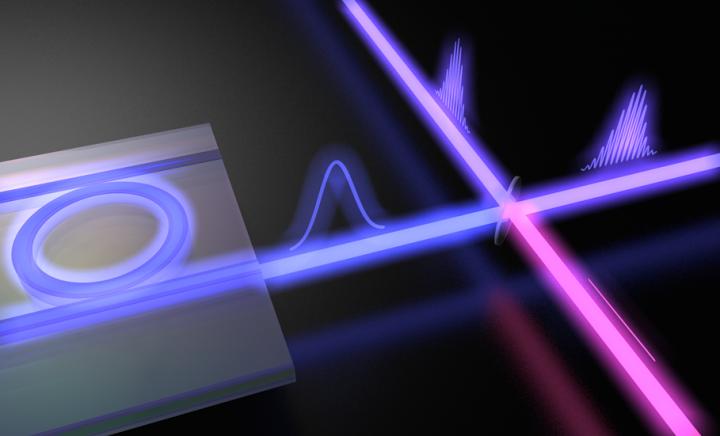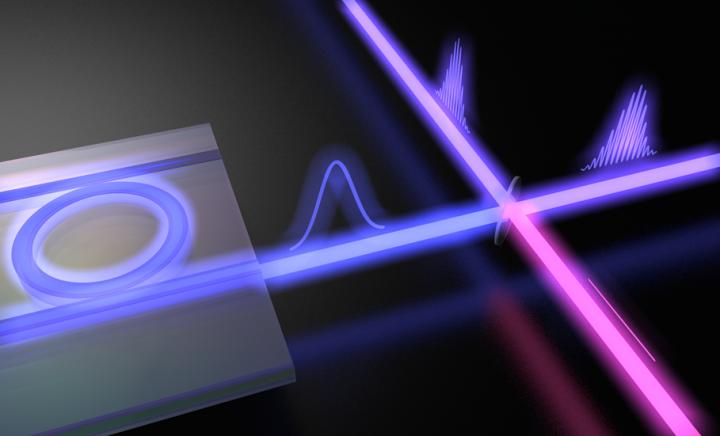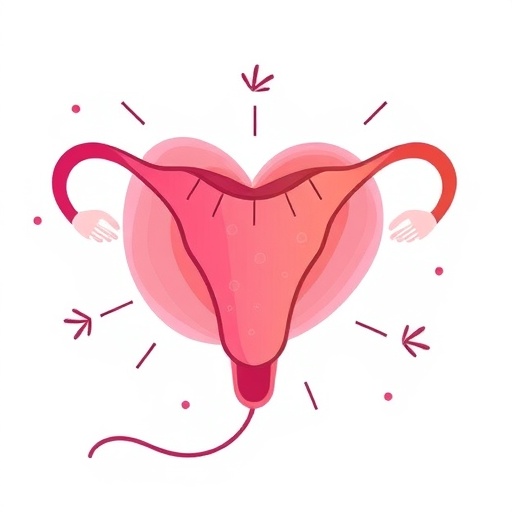
Credit: Ultrafast Optical Processing Group, INRS-EMT
The Ultrafast Optical Processing Group at INRS (Institut national de la recherche scientifique) has redefined the limitations and constraints for ultra-fast pulsed lasers. As reported in Nature Photonics, researchers from the team of Prof. Roberto Morandotti have produced the first pulsed passively mode-locked nanosecond laser, with a record-low and transform-limited spectral width of 105 MHz–more than one hundred times lower than any mode-locked laser to date. With a compact architecture, modest power requirements, and the unique ability to resolve the full laser spectrum in the radio frequency (RF) domain, the laser paves the way towards full on-chip integration for novel sensing and spectroscopy implementations.
Lasers emitting intense light-pulse trains have enabled the observation of numerous phenomena in many different research disciplines, and are the basis of state-of-the-art experiments in modern physics, chemistry, biology, and astronomy. However, high pulse intensities with low repetition rates come at the expense of mediocre noise properties. This is where passively mode-locked laser systems come in: They are the optimal choice for generating low-noise optical pulse trains. Such systems have, for example, made it possible to create stable optical frequency references for metrology (Nobel Prize, 2005) as well as intense ultra-short pulses (i.e., single-cycle pulses in the attosecond regime) for the study of high-intensity light-matter interactions.
While many mode-locking techniques have been demonstrated, mainly aimed at creating increasingly shorter pulses with broader spectra, little progress has been achieved so far in tackling the opposite problem: the generation of stable nanosecond narrow-bandwidth pulsed sources.
In their latest publication, the INRS research team presents a novel laser architecture that capitalizes on recent advances in nonlinear micro-cavity optics, pushing the boundaries further. Specifically, they exploit the narrowband filter characteristic of integrated microring resonators which, in addition to enabling high nonlinear phase shifts, make it possible to generate nanosecond pulses though mode-locking.
"The pulsed laser output generated has a spectral bandwidth so narrow it is inaccessible with state-of-the-art optical spectrum analyzers," says Michael Kues, postdoctoral fellow and principal author of the study. To characterize the laser's bandwidth, the researchers instead used a coherent optical beating technique. The record-low laser bandwidth made it possible, for the first time, to measure the full spectral characteristics of a mode-locked laser in the RF domain using widely available RF electronics only and confirming, in turn, the laser's strong temporal coherence.
Such stable narrow-bandwidth nanosecond pulsed sources are desirable for many sensing and microscopy applications, as well as for the efficient excitation of atoms and molecules (typically featuring narrow excitation bandwidths). From a fundamental perspective, the low and tractable number of optical laser modes, combined with the RF-accessibility of the associated spectrum, make the team's newly developed laser highly conducive to further study of both nonlinear mode coupling and complex mode-locking regimes.
###
ABOUT THE PUBLICATION
Published in Nature Photonics, the article "Passively mode-locked laser with an ultra-narrow spectral width" (DOI: 10.1038/nphoton.2016.271) is the result of an international research partnership involving researchers from Quebec, the United Kingdom, China, Russia, and Australia. The principal author is Michael Kues of the INRS Centre Énergie Matériaux Télécommunications. The study was produced by the Ultra-Fast Optical Processing Group led by Professor Roberto Morandotti and was supported by the Natural Sciences and Engineering Research Council of Canada (NSERC) through the Steacie, Canada Chair, and Discovery Grants programs, by the MESI PSR-SIIRI Initiative in Quebec, and by the Australian Research Council Discovery Projects scheme.
ABOUT INRS
Institut national de la recherche scientifique (INRS) is a graduate-level research and training university and ranks first in Canada for research intensity (average funding per professor). INRS brings together some 150 professors and close to 700 students and postdoctoral fellows at its four centres in Montreal, Quebec City, Laval, and Varennes. Its basic research is essential to the advancement of science in Quebec and internationally, and its research teams play a key role in the development of concrete solutions to the problems faced by our society.
SOURCES:
Corresponding authors:
Michael Kues, Ph.D., Postdoctoral Fellow, INRS, [email protected] Professor Roberto Morandotti, INRS, [email protected]
Stephanie Thibault, Communications Advisor, INRS, [email protected], +1 514-499-6612
Media Contact
Roberto Morandotti
[email protected]
@U_INRS
############
Story Source: Materials provided by Scienmag





